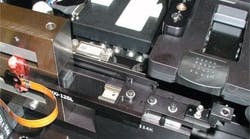Using microarray analysis tools, researchers can detect the effects of chemicals on biological cells, gaining a better understanding of how our genes work in the process. A probe, or the known substance or DNA strand in a test, is pipetted into the wells of a microarray, or small glass slide. The wells are tagged using fluorescence, photoluminescence, or another method that can detect chemical reactions. The drug being tested is then pipetted into all the wells. At this point, an image of the possible reaction in any cell can be produced.
One such tool for genomic studies and high-throughput drug screening using DNA and protein microarrays is the GenePix 4000 from Axon Instruments in Union City, Calif. The two-color scanner is based on technology developed at Axon, but also incorporates new optical and precision mechanical technologies, as well as innovative software and electronic designs.
Within the GenePix 4000 is a lens mounted to a slide. This lens focuses a laser at the surface of a microarray. Driven by a voice coil assembly, a scanned image is built pixel-by-pixel and line-by-line. The microarray advances in 5-μm steps over the lens while the lens moves quickly left and right. This left-toright scanning frequency is 10 or 16.6 Hz, depending on the model. Acceleration at turnaround is estimated to be 22 gs.
During the early design stages, Axon engineers were faced with the challenge of finding a linear slide that could reliably handle the incredible accelerations. In addition, the fundamental mechanical aspects of yaw, pitch, roll, accuracy, and repeatability still applied. Slides were rigorously tested at high speeds (10 to 12 Hz over full travel), uninterrupted until failure occurred. Many of them couldn’t stand the extremely high accelerations; some fell apart within days. Only the NDN 2-60.50 linear slide from Schneeberger, Bedford, Mass., survived the stringent testing and demonstrated the performance Axon needed.
The slide is precision ground, not stamped, which accounts for the high level of accuracy it can maintain. It’s made of corrosion-resistant steel, which helps protect it from chemical elements often found in biomedical research. In addition, it has a cage-centering mechanism that helps avoid cage creep in highspeed applications.

